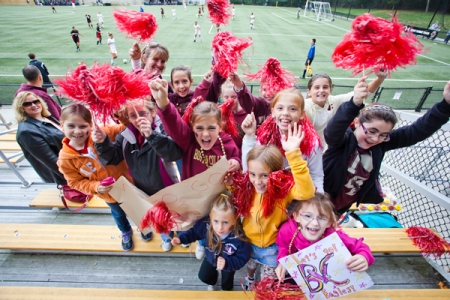
By
Snuggled in among groves of maple, birch and pine trees along the western boundary of the Newton Campus, the Boston College soccer/lacrosse facility is an architectural and environmental gem — as well as the home lair of some of the Eagles’ most successful sports teams.
The visual excellence of the facility reflects the level of play of its two fall occupants, BC’s men’s and women’s soccer teams. Coach Ed Kelly’s men’s squad boasted a 12-4 overall record and was ranked 13th nationally going into last night’s regular season finale against North Carolina. Women’s Coach Alison Foley’s club finished the regular season with an 11-5-2 mark and holds the No. 15 spot in the latest Soccer World rankings. Both teams are expected to qualify for the NCAA tournaments that begin later this month.
“Our players love playing on their home turf,” says Foley, who has coached the BC women’s team for 16 seasons. “Its surface is one of a kind and different than all other schools in the ACC. That is a huge advantage.”
There’s another plus for the Newton facility, according to the coach: “This is the most beautiful time of the year out there as all the trees around the field are changing color,” she says, noting the field’s sylvan setting.
The pristine stadium was upgraded in 2008 with the installation of an environmentally friendly artificial surface and last summer was again improved with the addition of enhanced external landscaping and stonework.
Originally opened as a natural grass pitch in 1999, the facility was named “College Soccer Field of the Year” by the Soccer Managers’ Association. Six light towers were added in 2003 – specially aimed and shielded so that the arcs would not disturb local residents in the adjacent Rochester Road neighborhood. By agreement with abutters, no more than 10 night games per year are played at the facility.
A 2008 refurbishment of the facility included the installation of a Polytan artificial surface, a German-manufactured system that is used on soccer pitches at the World Cup stadium in Stuttgart and the Olympic Stadium in Munich. BC’s Polytan field was the first major field of its type to be installed in the United States.
An inch-thick e-layer of artificial rubber underneath the field provides longevity and safety, says Assistant Athletics Director for Facilities Joseph Shirley, and the surface is filled in with BionPro, new-generation environmentally friendly polymers that keep the field cool as well as maintaining a proper playing surface.
“We met with the neighborhood association [in Newton] throughout the project,” Shirley says. “Officials from the company met with neighbors to discuss and answer questions about all of the products that were to be included in the new turf system. I think that it helped make them feel that they were a part of the project.”
Shirley says the installation of artificial turf in the facility has nearly tripled the availability of the field for both student-athletes and student recreation. Club sports and intramural competition share the facility with the BC soccer and lacrosse teams.
“In the past, if we had games late in the season, we would have had to re-sod the areas in the goal mouth and the field would have been badly chewed up. Now all we have to do is groom the field and it’s ready to go.”
In addition to the artificial surface, the 2008 renovation included a grass-covered berm on the south end zone of the field that is ideal for families or student groups to picnic or relax while watching a game.
The stadium area includes bench seating for 1,000 fans on maroon and gold bleachers and spacious concrete patios on either end of the field for the fans who like to watch their soccer from the “standing room” section – as is the custom at many European soccer venues.
To see a few scenes from a recent women's soccer game at the field, click here for a Flickr slideshow.



